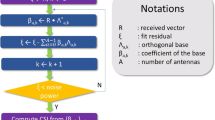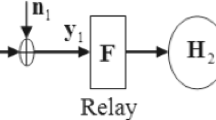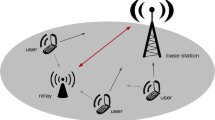Abstract
Channel state information is very important in cooperative communication for performance improvement or signal demodulation. Previous works on channel state information estimation mainly focus on least squares and minimum mean squared error estimators. In this work, several new maximum likelihood and maximum a posteriori estimators for the cooperative network are proposed. Two of them estimate the individual channel powers of different links using all pilots from the source node, while two of them estimate the individual channel gains of different links using pilots from the source node as well as the relay node. Numerical results show that the estimation error decreases when the signal-to-noise ratio increases or when the number of pilots increases. The estimators for the individual channel gains have normalized mean squared errors of less than 0.001 when the signal-to-noise ratio is 30 dB, and their bit error rate performances are very close to the perfect case. Importantly, channel estimation is performed at the destination only such that there is no extra complexity at the relay node.






Similar content being viewed by others
References
Laneman, J. N., & Wornell, G. W. (2000). Energy-efficient antenna sharing and relaying for wireless networks, In Proceedings of the IEEE Wireless Communication of Networking Conference, Chicago, USA (Vol. 1, pp. 7–12).
Sendonaris, A., Erkip, E., & Aazhang, B. (2003). User cooperative diversity-part I, II. IEEE Transactions on Communications, 51, 1927–1948.
Peng, M., Liu, Y., Wei, D., Wang, W., & Chen, H.-H. (2011). Hierarchical cooperative relay based heterogeneous networks. IEEE Wireless Communications, 18, 48–56.
Zhou, B., Hu, H., Huang, S.-Q., & Chen, H.-H. (2013). Intracluster device-to-device relay algorithm with optimal resource allocation. IEEE Transactions on Vehicular Technology, 62, 2315–2326.
Bolcskei, H., Nabar, R. U., Oyman, O., & Paulraj, A. J. (2006). Capacity scaling laws in MIMO relay networks. IEEE Transactions on Wireless Communications, 5, 1433–1444.
Chen, Y., Wang, C.-X., Xiao, H., & Yuan, D. (2011). Novel partial relay selection schemes for AF relaying in Nakagami-\(m\) fading channels. IEEE Transactions on Vehicular Technology, 60, 3497–3503.
Andreev, S., & Galinina, O. Y. (Dec. 2011). Koucheryavy, Energy-efficient client relay scheme for machine-to-machine communication. In Proceedings of GLOBECOM 2011.
Laneman, J. N., Tse, D. N. C., & Wornell, G. W. (2004). Cooperative diversity in wireless networks: Efficient protocols and outage behavior. IEEE Transactions on Information Theory, 50, 3062–3080.
Bradford, G. J., & Laneman, J. N. (2009). An experimental framework for the evaluation of cooperative diversity. In IEEE CISS 2009, Baltimore, USA.
Chen, D., & Laneman, J. N. (2006). Modulation and demodulation for cooperative diversity in wireless systems. IEEE Transactions on Wireless Communications, 5, 1785–1794.
Chen, X., Lei, L., Zhang, H., & Yuen, C. (2015). Large-scale MIMO relaying techniques for physical layer security: AF or DF? IEEE Transactions on Wireless Communications, 14, 5135–5146.
Wirth, T., Thiele, L., Haustein, T., Braz, O., & Stefanik, J. (2010). LTE amplify and forward relaying for indoor coverage extension. In Proceedings of the IEEE VTC 2010-Fall, Ottawa, Canada.
Berger, S., Kuhn, M., Wittneben, A., Unger, T., & Klein, A. (2009). Recent advances in amplify-and-forward two-hop relaying. In IEEE communications magazine (pp. 50–56).
Zetterberg, P., Mavrokefalidis, C., Lalos, A. S., & Matigakis, E. (2009) Experimental investigation of cooperative schemes on a real-time DSP-based testbed. In EURASIP journal on wireless communications and networking (Vol. 2009).
Patel, C. S., & Stuber, G. L. (2007). Channel estimation for amplify and forward relay based cooperation diversity systems. IEEE Transactions on Wireless Communications, 6, 2348–2356.
Lioliou, P., Viberg, M., & Coldrey, M. (2012). Efficient channel estimation techniques for amplify and forward relaying systems. IEEE Transactions on Communications, 60, 3150–3155.
Nguyen, D. H. N., & Nguyen, H. H. (2010). Power allocation for channel estimation and performance of mismatched decoding in wireless relay networks. IEEE Transactions on Vehicular Technology, 59, 4639–4645.
Gao, F., Cui, T., & Nallanathan, A. (2008). On channel estimation and optimal training design for amplify and forward relay networks. IEEE Transactions on Wireless Communication, 7, 1907–1916.
Sadough, S. M. S., & Chamideh, Z. (2015). Efficient variational Bayesian method for joint channel estimation and signal detection in OFDM-based AF relay networks. IEEE Communications Letters, 19, 1786–1789.
Canonne-Velasquez, L., Le, H. N., & Ngoc, T. L. (2012). Cascaded doubly-selective channel estimation in multi-relay AF OFDM transmissions. In Proceedings of the IEEE ICC 2012, Ottawa, Canada (pp. 3836–3840).
Liouliou, P., Viberg, M., & Matthaiou, M. (2012). Bayesian approach to channel estimation for AF MIMO relaying systems. IEEE Journal on Selected Areas in Communications, 30, 1440–1451.
Proakis, J. G. (2001). Digital communications (4th ed.). New York: McGraw-Hill.
Behbahani, A.S., & Eltawil, A. (2008). On channel estimation and capacity for amplify and forward relay networks. In Proceedings of the IEEE Globecom 2008, New Orleans, USA. (pp. 1–5).
Yomo, H., & de Carvalho, E. (2007). A CSI estimation method for wireless relay networks. IEEE Communications Letters, 11, 480–482.
Gao, F., Jiang, B., Gao, X.-Q., & Zhang, X.-D. (2011). Superimposed training based channel estimation for OFDM modulated amplify-and-forward relay networks. IEEE Transactions on Communications, 59, 2029–2039.
Amin, O., Gedik, B., & Uysal, M. (2010). Channel estimation for amplify-and-forward relaying: Cascaded against disintegrated estimators. IET Communications, 4, 1207–1216.
Aerts, N., Moeneclaey, M. (2012). Pilot-based ML estimation in amplify-and-forward cooperative networks. In Proceedings of the IEEE WCNC 2012, Shanghai, China (pp. 1044–1048).
Zhang, S., Gao, F., He, X. D., & Pei, C. X. (2013). Segment training based individual channel estimation in one-way relay network with power allocation. IEEE Transactions on Wireless Communications, 12, 1300–1309.
Arti, M. K., Malik, R. K., & Schober, R. (2012). Joint channel estimation and decoding of space-time block codes in AF MIMO relay networks. InProceedings of the IEEE SPCOM 2012, Banglore, India(pp. 1–5,).
Arti, M. K., Malik, R. K., & Schober, R. (2013). Channel estimation and decoding of OSTBC in two-way AF MIMO relay networks. In Proceedings of the IEEE VTC 2013, Las Vegas (pp. 1–5).
Beaulieu, N. C., & Chen, Y. (2007). A MAP estimator for the m parameter in Nakagami fading ultra-wide bandwidth indoor channels. IEEE Transactions on Wireless Communications, 6, 840–844.
Beaulieu, N. C., & Chen, Y. (2015). MAP estimation of the Ricean K factor. Canadian Journal of Electrical and Computer Engineering, 38, 130 131.
Alouini, M.-S., & Goldsmith, A. J. (2000). Adaptive modulation over Nakagami fading channels. Kluwer Wireless Personal Communications, 13, 119–143.
Chen, Y., Alouini, M.-S., Tang, L., & Khan, F. (2012). Analytical evaluation of adaptive-modulation-based opportunistic cognitive radio in Nakagami-m fading channels. IEEE Transactions on Vehicular Technology, 61, 3294–3300.
Pauluzzi, D. R., & Beaulieu, N. C. (2000). A comparison of SNR estimation techniques for the AWGN channel. IEEE Transactions on Communications, 48, 1681–1691.
Chen, Y., & Beaulieu, N. C. (2007). Maximum likelihood estimation of SNR using digitally modulated signals. IEEE Transactions on Wireless Communications, 6, 210–219.
Cao, N., Wang, F., Chen, Y., Hu, X., & Mao, M. (2013). Estimation of the average fading powers for AF relay system. IEEE Communications Letters, 17, 135–138.
Schonhage, A., Grotefeld, A. F. W., & Vetter, E. (1994). Fast algorithms-a multitape turing machine implementation. Mannheim: BI Wissenschafts-Verlag.
Knuth, D. (1997). The Art of computer programming (3rd ed., Vol. 2). Boston: Addison-Wesley.
Author information
Authors and Affiliations
Corresponding author
Appendices
Appendix 1: derivation of (10) and (11)
The likelihood function can be written as
where \(\bar{u}=[u_1 u_2 \cdots u_I]\) and \(\bar{v}=[v_1 v_2 \cdots v_I]\). This gives the log-likelihood function as
By taking the derivatives of (24) with respect to \(g_R\), \(g_I\), \(h_R\) and \(h_I\) and setting the results to zero, one has
Moreover, by solving (27) and (28) for \(h_R\) and \(h_I\), respectively, and substituting them in (25) or (26), one can derive (10). Also, using (27) and (28), one has (11).
Appendix 2: derivation of (12) and (13)
The likelihood function using (3) and (4) is derived as
where the extra exponential function comes from the distribution of the channel gain. From (29), the log-likelihood function is
Then, by taking derivatives of (30) with respect to \(g_R\), \(g_I\), \(h_R\) and \(h_I\) and setting them to zero, one has
By solving (33) and (34) for \(h_R\) and \(h_I\), respectively, and using them in (31) or (32), one has an equation for \(x=g_R^2+g_I^2\) as
This nonlinear equation does not have a closed-form expression for the solution but can be easily solved using numerical computations. Assume that the solution to (35) is \(x_0\). Thus, one has (12). Using (33), (34) and (12), the MAP estimator for the channel power \(|h|^2\) can be derived as (13).
Rights and permissions
About this article
Cite this article
Gao, Y., Chen, Y. Channel estimation for AF relaying using ML and MAP. Wireless Netw 24, 3161–3170 (2018). https://doi.org/10.1007/s11276-017-1526-x
Published:
Issue Date:
DOI: https://doi.org/10.1007/s11276-017-1526-x




